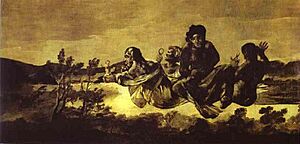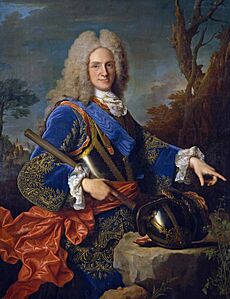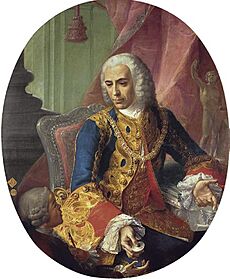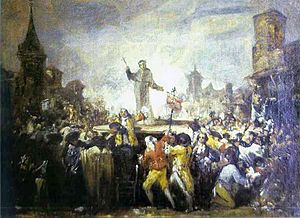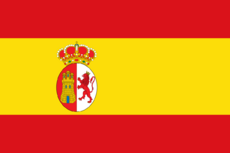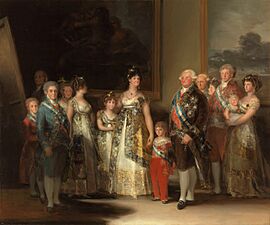History of Spain (1700–1808) facts for kids
Quick facts for kids
Reino de España
|
|||||||||||||||||
|---|---|---|---|---|---|---|---|---|---|---|---|---|---|---|---|---|---|
| 1700–1808 | |||||||||||||||||
|
Motto: Plus Ultra
"Further Beyond" |
|||||||||||||||||
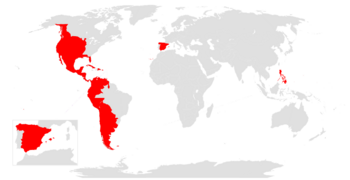
Territories that were ever part of the Spanish Empire during the Enlightenment, between 1713 and 1808.
|
|||||||||||||||||
| Capital | Madrid | ||||||||||||||||
| Official languages | Spanish | ||||||||||||||||
| Regional languages | |||||||||||||||||
| Religion | Catholicism | ||||||||||||||||
| Demonym(s) | Spaniard, Spanish | ||||||||||||||||
| Government | Absolute monarchy | ||||||||||||||||
| Monarch | |||||||||||||||||
|
• 1700–1724 (first)
|
Philip V | ||||||||||||||||
|
• 1808 (last)
|
Ferdinand VII | ||||||||||||||||
| Legislature | Cortes of Castile | ||||||||||||||||
| Historical era | Enlightenment era | ||||||||||||||||
|
• Death of Charles II
|
1 November 1700 | ||||||||||||||||
| 1700–1715 | |||||||||||||||||
| 1740–1748 | |||||||||||||||||
| 1756–1763 | |||||||||||||||||
| 1807–1814 | |||||||||||||||||
| 24 September 1808 | |||||||||||||||||
| Currency | Spanish real | ||||||||||||||||
| ISO 3166 code | ES | ||||||||||||||||
|
|||||||||||||||||
The Kingdom of Spain (Spanish: Reino de España) began a new chapter in 1700. This was when Charles II, the last king from the Habsburg family in Spain, died without children. His death led to the War of the Spanish Succession. This war was fought over who would rule Spain next: a prince from the Bourbon family (Philip of Anjou) or a prince from the Austrian Habsburg family (Archduke Charles).
After the war ended in 1715 with the Peace of Utrecht, Philip V became king. He had to promise that Spain and France would never be ruled by the same person. Spain then started a time of big changes and improvements. New ideas from the Age of Enlightenment spread across Spain and its colonies. However, Napoleon Bonaparte's invasion of Spain in 1808, during the Peninsular War, caused a lot of trouble. Even though France was defeated, this period of unrest eventually led to the Spanish American wars of independence in Spain's overseas empire.
Historians often call the 18th century in Spain "Bourbon Spain." This is because the Bourbon family continued to rule Spain for many years after this period.
Contents
Philip V: Spain's First Bourbon King (1700–1746)
The last years of King Charles II were difficult. He was the last Habsburg king of Spain and had no children. European countries worried about who would take over after him. Spain was a very rich and powerful country because of its huge empire in the New World and the Philippines. If France and Spain were to unite under one ruler, it would upset the balance of power in Europe.
The War for Spain's Throne
France (with the Bourbons) and Austria (with the Habsburgs) went to war to decide who would be the next king of Spain. This war, called the War of the Spanish Succession (1702–1714), was about controlling Spain's wealth and empire. France won the war, but the Treaty of Utrecht made sure that the French and Spanish royal families would never officially unite.
Spain lost some of its European territories in this war. It gave up lands in Italy and the Spanish Netherlands. Britain also gained control of Gibraltar and the island of Menorca. Philip V, the new king, promised to give up any claim to the French throne.
Big Changes in Government
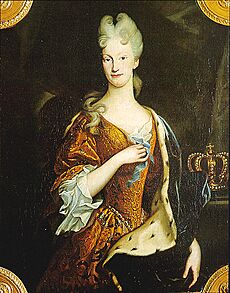
Philip V was a strong leader who made many changes. He made the Spanish government more centralized. This meant that power moved from regional parliaments (called cortes) to the central government in Madrid. He also made laws more uniform across different parts of Spain. The Nueva Planta decrees (1716) removed special privileges from some regions, especially Aragon, which had supported the losing Habsburg side. This helped create a more unified Spain.
Philip V also changed how the government was run. He replaced the old system of councils with four main departments, like modern ministries. These departments handled things like foreign affairs, justice, the army, and the overseas empire. The people in charge of these departments were chosen for their skills, not just because they were nobles. Philip V also improved how taxes were collected, which helped the new monarchy pay for its many wars.
The king also wanted to boost Spain's economy. He aimed to expand Spanish manufacturing and farming. He also made it easier for Spanish ports to trade with the overseas empire. Before, only Seville and later Cádiz had this right. This change helped Spanish businesses grow.
Spain's Wars and Ambitions
Philip V's second wife, Elizabeth Farnese, had a strong influence on his decisions. She wanted Spain to regain territories it had lost in Italy. This led Spain into several costly wars. In 1717, Spain invaded Sardinia and then Sicily. This made other European powers like Britain, France, Austria, and the Netherlands form an alliance against Spain. Spain was defeated and had to sign a peace treaty in 1720.
Spain tried again to get back lost territories like Menorca and Gibraltar from Britain in 1727. However, Spain was left alone when its allies didn't help. Philip V was forced to make peace in 1729. Even so, Elizabeth Farnese managed to secure rights for her sons to rule in Italian duchies like Parma and Tuscany.
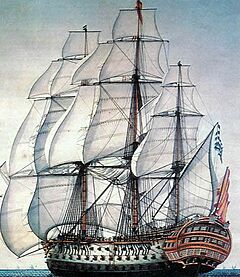
After 1729, Philip V became more careful. He sought a closer alliance with France. This alliance helped Spain regain the kingdoms of Naples and Sicily for his son, who would later become Charles III of Spain. Spain also gained the Duchy of Parma and Duchy of Guastalla in other wars. These actions helped restore Spain's power in Italy.
Ferdinand VI: A Time of Peace (1746–1759)
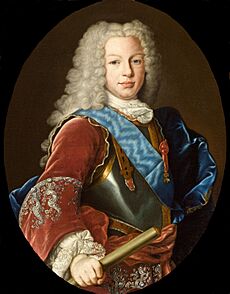
When King Philip V died, his son Ferdinand VI became king. Ferdinand was Philip's son from his first marriage. He was very close to his wife, Barbara of Portugal. She encouraged a policy of neutrality, meaning Spain would try to stay out of wars.
Ferdinand's rule was generally peaceful and prosperous. He continued many of his father's reforms. He was a kind ruler, for example, he removed taxes for a region hit by drought in 1755. He also spent a lot of money rebuilding parts of the country.

During Ferdinand's reign, two main groups advised the king. One group, led by Marquis of Ensenada, wanted a strong alliance with France. The other group, led by Jose de Carvajal y Láncaster, preferred a closer relationship with Britain. Carvajal believed that Britain's naval power and trade could help Spain.
Carvajal's biggest success was an agreement with Portugal in 1750. This agreement ended a long-running conflict over land in South America. However, this agreement also led to problems with the Jesuit religious order and the native Guaraní in the region. This conflict, known as the War of the Seven Reductions, damaged the relationship between the Spanish government and the Jesuits.
Eventually, a scandal led to the dismissal of Ensenada. An Irishman named Ricardo Wall took over as chief minister. Wall successfully kept Spain out of the Seven Years' War, which was raging across Europe.
Queen Barbara died in 1758, and King Ferdinand was heartbroken. He died a year later in 1759, without children.
Charles III: An Enlightened King (1759–1788)
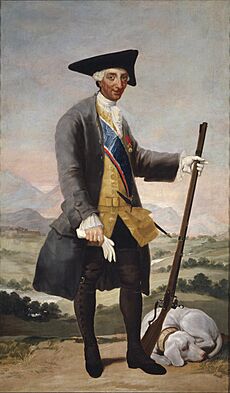
Ferdinand VI's half-brother, Charles III, became the next king of Spain. Charles had already been king of Naples and Sicily. There, he had learned about "enlightened despotism," a way of ruling where the monarch uses new ideas to improve the country. He brought Italian advisors with him to Spain to help with reforms. One of his most important advisors was Marquis of Esquilache.
Spain in the Seven Years' War
When Charles III became king, Spain was neutral in the Seven Years' War. However, Charles had a dislike for Britain. In 1762, he decided to join the war on France's side. This decision did not go well for Spain. Britain captured important cities like Havana (in Cuba) and Manila (in the Philippines).
In 1763, the Treaty of Paris (1763) ended the war. Spain had to give Spanish Florida to Britain. But Spain received the vast territory of Louisiana from France as compensation. After the war, Charles III could focus on improving Spain itself.
Important Reforms
Charles III believed in making the government stronger and more modern. He wanted to reduce the power of the Catholic Church and the wealthy landowners, who owned much of Spain's land but often did not use it productively. Spain's population was growing, and there was a need for more efficient use of resources.
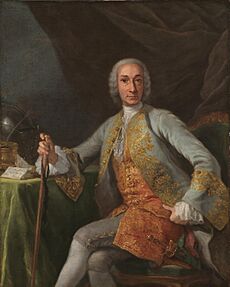
Following ideas from the Age of Enlightenment, Charles III took steps to strengthen the crown's power over the Church. He expelled the Jesuits from Spain and its empire in 1767. The Inquisition, a powerful religious court, was also reduced in power.
Charles III also introduced land and agricultural reforms. He supported merchants and the growing middle class. He believed in free trade and lowered trade barriers that had been in place for centuries. For example, the Marquis of Esquilache allowed free trade of grain in 1765. However, this led to riots in 1766 because grain prices went up.
Even though Charles III believed in a strong central government, he also encouraged local economic development. He improved Spain's roads and other infrastructure. He also created a unified money system.
After the grain riots, Esquilache was removed from power. A new minister, Count of Floridablanca, became very important. He continued many of Charles III's reforms. Floridablanca created a true cabinet system of government and established Spain's first national bank, the National Bank of San Carlos, in 1782. He also reformed Spain's education system after the Jesuits were expelled.

One of Floridablanca's most lasting achievements was opening up free trade with Spain's empire in the New World to more foreign ships. This helped boost the economy of the colonies.
In 1779, Spain joined France and the Dutch Republic in the American Revolutionary War against Britain. Spain wanted to regain territories it had lost. Spanish forces, led by Bernardo de Gálvez, recaptured Pensacola, Florida and The Bahamas. The Treaty of Paris (1783) restored Florida to Spain.
Charles III is remembered as one of Spain's most successful monarchs. He provided strong and intelligent leadership. He chose capable ministers and his personal life earned the respect of his people.
Charles IV: Decline and Fall (1788–1808)
King Charles III died in 1788, and his son, Charles IV, became king. Just seven months later, the French Revolution began in France. This event would greatly impact Spain.
Charles IV was not as interested in politics as his father. He preferred hunting. His policies were often influenced by his wife, Maria Luisa of Parma, and her close advisor, Manuel Godoy. Godoy, a military officer, became chief minister in 1792.

The spirit of reform that had marked Charles III's reign faded under Charles IV. The queen and Godoy were not interested in improving the government. They saw the reforms as too liberal, like the ideas that were causing chaos in France. Many of Charles III's changes were undone.
After the French king was executed in 1793, Spain went to war with France in the War of the Pyrenees. The Spanish army was not well-prepared and suffered defeats. In 1795, Godoy signed the Treaty of Basel with France, giving up Santo Domingo (part of Hispaniola) to the French Republic.
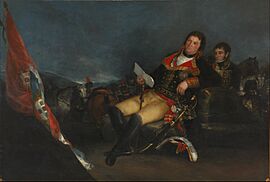
Spain then allied with France in 1796. This led to conflict with Britain. The British blockaded Spain's ports, cutting off its empire. The Spanish fleet was defeated by the British in 1797, and Britain occupied Menorca and Trinidad. In 1800, Spain returned Louisiana to France.
In 1805, the Spanish navy joined the French fleet in a major battle against the British. This was the Battle of Trafalgar. The Spanish and French suffered a terrible defeat at the hands of Admiral Lord Horatio Nelson. This loss confirmed British dominance at sea and made Spain doubt its alliance with Napoleon's France.
After Trafalgar, Godoy tried to distance Spain from Napoleon. But after Napoleon defeated other European powers, Spain rejoined his side. However, Napoleon had lost faith in Godoy and King Charles IV. There was also growing support in Spain for the king's son, Ferdinand, who was popular and opposed Godoy.
Ferdinand VII and Napoleon's Influence (1808)
In 1808, Spain and France agreed to divide Portugal. French and Spanish troops quickly occupied Portugal. Meanwhile, Prince Ferdinand traveled to France, hoping to get Napoleon's support to remove Godoy from power. This led to riots in Spain. During the Tumult of Aranjuez, Godoy was arrested, and Charles IV was forced by his son Ferdinand to give up his throne.
However, Napoleon did not trust the Spanish royal family. When Ferdinand went to France to meet Napoleon, Napoleon pressured Ferdinand to give the throne back to his father, Charles IV. Then, Napoleon convinced Charles IV to give the throne to him instead. Napoleon then placed his own older brother, Joseph Bonaparte, on the Spanish throne.
To make this change seem legal, Napoleon gathered a group of Spanish nobles in France. They signed the Bayonne Constitution in July 1808, which was Spain's first written constitution. But the Spanish people decided to resist this foreign rule, which started the Peninsular War.
Images for kids
-
His Majesty's Ship "Victory", Capt. E. Harvey, in the Memorable Battle of Trafalgar between two French Ships of the Line by John Constable





